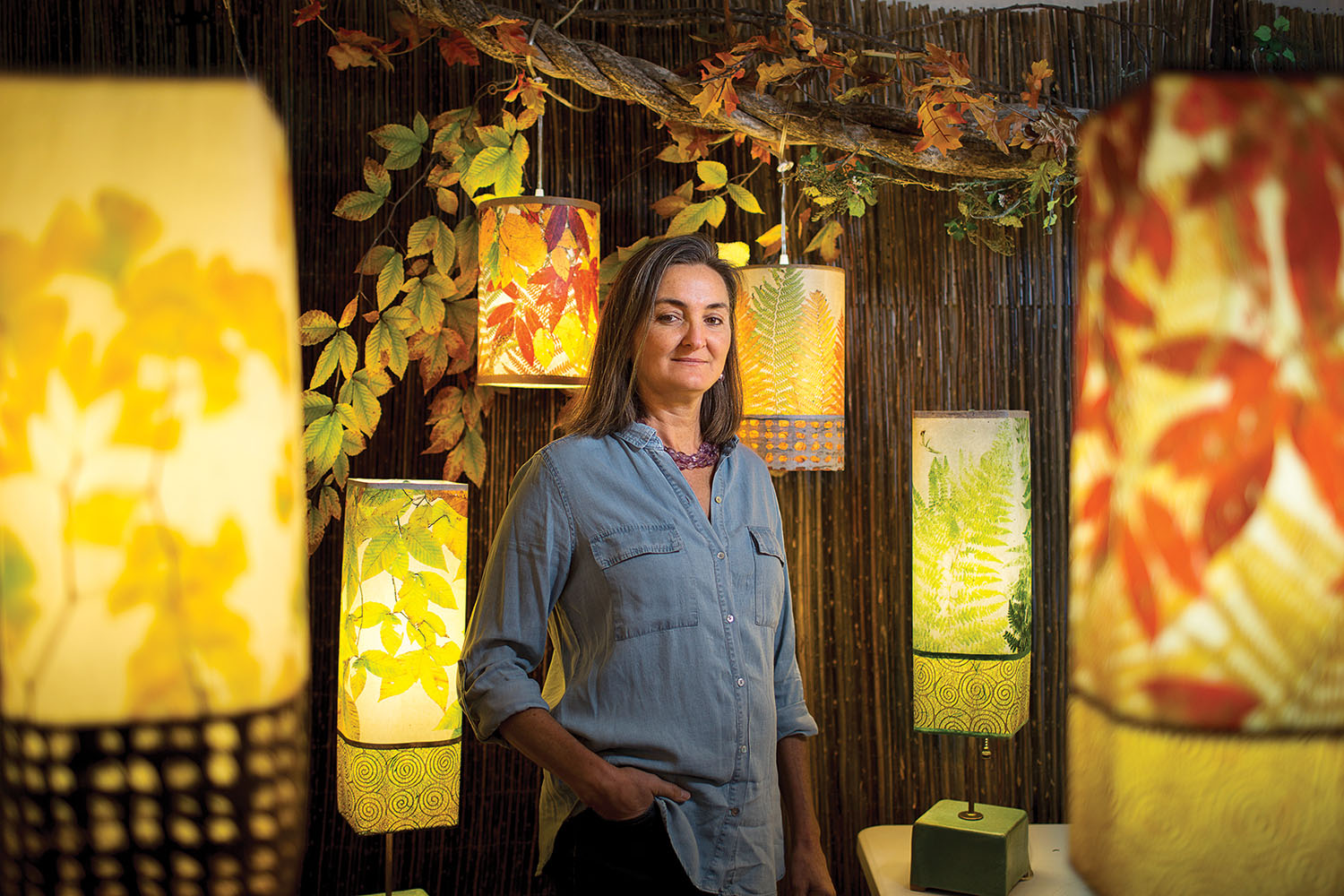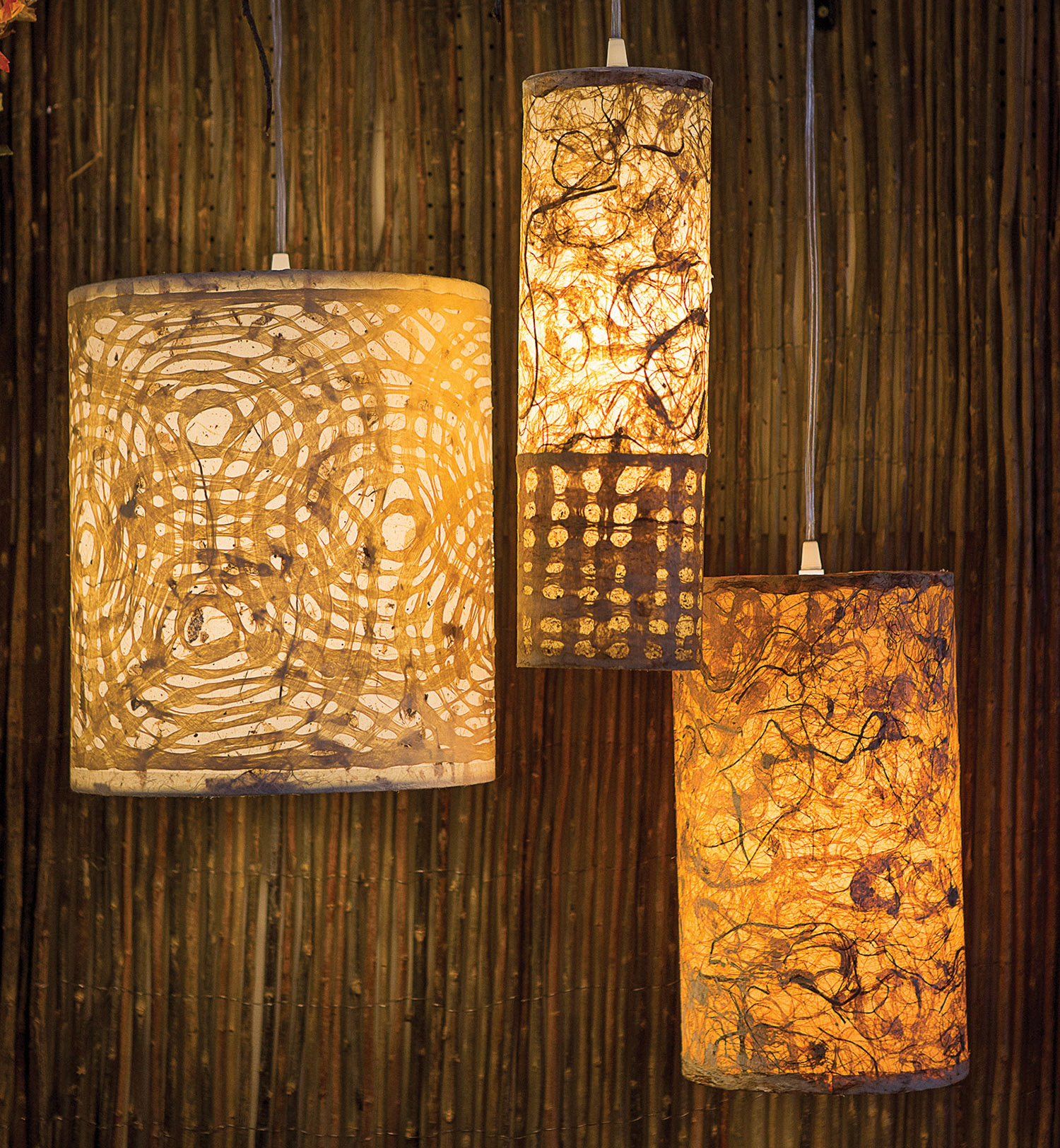
In the cold light of a winter’s day, Leah Baker returned to lamps. Maybe the bitter air and waning afternoons of 2012 inspired her, she conjectures. “Maybe I felt a little seasonal affective disorder, even.” Regardless, the Eastern North Carolina native craved color, creative expression, and, above all, light.
From a bedroom worktable, she began crafting paper shades and stone bases. The production eventually moved to an airy space on Weaverville’s North Main Street, where Baker now runs Luminosa Lighting, an upscale lamp studio.
She never sought to be a lamp maker. Rather, she learned the trade 20 years ago, almost by accident.
“I was at a junction in my life,” she says. In 1992, Baker left a graphic-design career in California for massage-therapy school. But somewhere along the way, she met furniture designer Sequoia Pawan Madan. His New Mexico-inspired pieces possessed a certain allure. Monkey-wood tables flaunted river-rock accents and bed frames paraded vine-like, iron spindles.
He needed seed money for a gallery and Baker loaned him $7,000 using her credit cards.
“I only knew [Madan] for three months,” she says, seemingly astonished by her former audacity. “But his designs incorporated nature so organically.”
Madan, who now owns a posh furniture store in Santa Fe, taught Baker to produce lamps. In his Mill Valley, California, garage, they made paper by hand and impressed botanicals into shades. She learned to appreciate mood and ambience, developing an aversion to the bare bulb. “Too bright,” says Baker. “It hurts my eyes.”

But after the two-year apprenticeship, Baker launched into her massage-therapy practice. She moved back to North Carolina, built a home, and cared for her mother. Decades passed, and her business continued to overshadow her visions of warm glows. Then, in 2012, she says she began “exploring, experimenting, constructing.”
From this spawned the whimsical, Zen-like “Botanical Inclusions” collection. Here, each leaf on the lamp shade possesses personality and character. Ginkgoes float against a creamy backdrop of swirls, yet remain grounded by a hearty stone base. Other lamps rest on modern metal, knotty wood, or clay shaped by Weaverville potter Rob Mangum.
Spirals reappear in her two most recent collections. They contrast against cadmium-yellow accents or flank browning ferns. The delicate twists and whirls are manifestations of organic sentiments, explains Baker. They nod to curled fronds and shapeless water. “There is something elemental about swirls,” she says. “They coincide with nature.”
Using a digitized process she’d prefer not to disclose, Baker transfers actual fall sourwood leaves, golden ferns, and beech stems onto paper. Her “Appalachian Forest Print” collection attests to autumns in Cashiers, where she worked for five years during high tourist seasons.
“I’m usually driving when I see the leaves,” says Baker. “Then I think: ‘How can I capture that in a way that will translate when someone turns the lamp on?’”
She considers how spaces evolve when that switch is flipped. Light must be filtered through a soothing medium, since “it can make the room cold or warm,” she says. In contrast to the cool industrials that are so trendy right now, Baker prefers warmer red and welcoming brown light. She also toys with softer blues and greens, like turquoise and sapphire.
“Summer Green Grass,” for instance, is a tall lamp featured on Baker’s Etsy site, created with handmade papers from Mexico and Nepal, layered to resemble a honeycomb. Its amber counterpart, made instead with a rich egg-yolk yellow, emits a more cordial luminescence. It challenges the cold contemporary with an ambience that’s both welcoming and stylish.
Others in her “Paper Fusions” collection entertain similarly fragile materials, like vivid Taiwanese prints or bark paper produced by the Otomi Indians in Mexico’s mountains. In 2013, Baker even traveled to a Nepalese mill to observe a small paper production. Colorful rollers dotted the facility, a building that once served as a UNICEF card-making shop.
“A fellow there would pull every sheet from a vat of pulp,” says Baker. “He’d then stretch the paper across felt to dry.”
However striking, the handmade products are temperamental: stiff and prone to shrinking. “It can be difficult to work with,” she continues. “It’s too delicate for mass production.”
And therein lies the need for human handling. Lighting a home, argues Baker, requires tact more intimate than what machinery can provide. Lamps “make or break” a space. They prime an environment’s tenor, and leave its lasting impression
“They’re the finishing touch.”
Learn more about Leah Baker and see her work at luminosalighting.com.

Hey Leah your creations are getting ever more beautiful.